新人教版七年级英语下册 unit2六课时-优质教案.doc
人教版新目标七年级英语下册 Unit 2教学设计

人教版新目标七年级英语下册 Unit 2教学设计一. 教材分析人教版新目标七年级英语下册Unit 2主要围绕日常生活话题,让学生学会描述日常活动、表达喜好和计划。
本单元包括三个部分:听说课、读课和综合语言运用课。
听说课主要训练学生的听说能力,读课通过阅读提高学生的理解能力,综合语言运用课则培养学生的综合语言运用能力。
二. 学情分析七年级的学生已经掌握了基本的英语语音、词汇和语法知识,具备一定的听说读写能力。
但部分学生对英语学习仍存在恐惧心理,缺乏自信心。
因此,在教学过程中,教师需要关注学生的情感态度,激发他们的学习兴趣,提高课堂参与度。
三. 教学目标1.知识目标:学生能够掌握日常生活中常用的词汇和表达方式,如goto school, read books, watch TV等。
2.能力目标:学生能够在真实情境中运用所学知识进行日常交流,提高听、说、读、写的能力。
3.情感目标:学生能够积极参与课堂活动,提高学习英语的自信心和兴趣。
四. 教学重难点1.重点:学生能够熟练运用日常词汇和句型描述日常生活。
2.难点:学生能够正确使用一般现在时表达习惯性动作和喜欢的事物。
五. 教学方法1.任务型教学法:通过完成各种实际任务,让学生在实践中学习、运用英语。
2.情境教学法:创设真实的语境,激发学生的学习兴趣和积极性。
3.情感教学法:关注学生的情感需求,营造轻松、愉快的学习氛围。
六. 教学准备1.教师准备:提前备课,熟悉教材内容和教学目标。
2.学生准备:预习新课内容,复习相关知识点。
3.教学资源:准备多媒体教学课件、图片、实物等。
七. 教学过程1.导入(5分钟)利用图片或实物展示日常生活中的人物和活动,引导学生谈论他们的日常喜好。
例如,展示一张学校操场上的图片,让学生描述图片中学生在做什么。
2.呈现(10分钟)教师通过PPT展示本节课的主要词汇和句型,如go to school, read books, watch TV等,并用例句展示如何运用这些词汇和句型。
人教版七年级下册英语Unit 2 教学设计
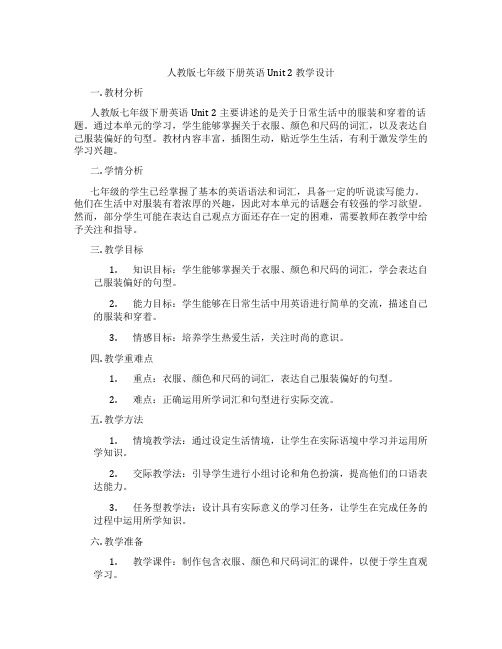
人教版七年级下册英语Unit 2 教学设计一. 教材分析人教版七年级下册英语Unit 2主要讲述的是关于日常生活中的服装和穿着的话题。
通过本单元的学习,学生能够掌握关于衣服、颜色和尺码的词汇,以及表达自己服装偏好的句型。
教材内容丰富,插图生动,贴近学生生活,有利于激发学生的学习兴趣。
二. 学情分析七年级的学生已经掌握了基本的英语语法和词汇,具备一定的听说读写能力。
他们在生活中对服装有着浓厚的兴趣,因此对本单元的话题会有较强的学习欲望。
然而,部分学生可能在表达自己观点方面还存在一定的困难,需要教师在教学中给予关注和指导。
三. 教学目标1.知识目标:学生能够掌握关于衣服、颜色和尺码的词汇,学会表达自己服装偏好的句型。
2.能力目标:学生能够在日常生活中用英语进行简单的交流,描述自己的服装和穿着。
3.情感目标:培养学生热爱生活,关注时尚的意识。
四. 教学重难点1.重点:衣服、颜色和尺码的词汇,表达自己服装偏好的句型。
2.难点:正确运用所学词汇和句型进行实际交流。
五. 教学方法1.情境教学法:通过设定生活情境,让学生在实际语境中学习并运用所学知识。
2.交际教学法:引导学生进行小组讨论和角色扮演,提高他们的口语表达能力。
3.任务型教学法:设计具有实际意义的学习任务,让学生在完成任务的过程中运用所学知识。
六. 教学准备1.教学课件:制作包含衣服、颜色和尺码词汇的课件,以便于学生直观学习。
2.练习题:准备相应的练习题,用于巩固所学知识。
3.教学道具:准备一些衣物道具,方便学生在课堂上进行展示和交流。
七. 教学过程1.导入(5分钟)利用多媒体展示一些时尚杂志封面,引导学生关注服装话题,激发学习兴趣。
2.呈现(10分钟)教师展示课件,呈现本节课的主要词汇和句型,如“T-shirt”、“trousers”、“blue”等,并解释其含义和用法。
3.操练(15分钟)学生分组进行角色扮演,运用所学词汇和句型进行对话,教师巡回指导并纠正错误。
人教版七年级英语下册Unit2教案
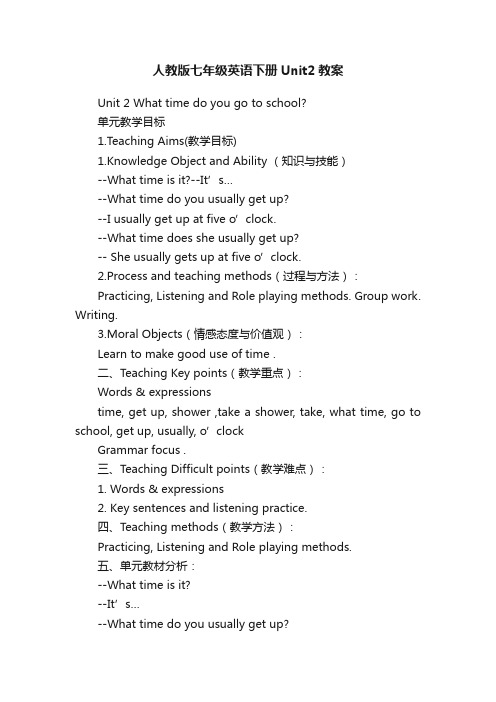
人教版七年级英语下册Unit2教案Unit 2 What time do you go to school?单元教学目标1.Teaching Aims(教学目标)1.Knowledge Object and Ability (知识与技能)--What time is it?--It’s…--What time do you usually get up?--I usually get up at five o’clock.--What time does she usually get up?-- She usually gets up at five o’clock.2.Process and teaching methods(过程与方法):Practicing, Listening and Role playing methods. Group work. Writing.3.Moral Objects(情感态度与价值观):Learn to make good use of time .二、Teaching Key points(教学重点):Words & expressionstime, get up, shower ,take a shower, take, what time, go to school, get up, usually, o’clockGrammar focus .三、Teaching Difficult points(教学难点):1. Words & expressions2. Key sentences and listening practice.四、Teaching methods(教学方法):Practicing, Listening and Role playing methods.五、单元教材分析:--What time is it?--It’s…--What time do you usually get up?--I usually get up at five o’clock.--What time does she usually get up?-- She usually gets up at five o’clock.学会用以上句型结构运用到口语交际当中,并努力创造性的使用语言,达到学以至用,提高学生分析问题和解决问题的能力。
人教版英语七年级下册Unit2教学设计

-学生分享自己喜欢的科目及原因,教师记录并板书相关词汇。
3.创设情境,邀请学生模拟上课场景,引导学生运用一般现在时描述学校生活。
-教师邀请几名学生上台,模拟上课场景,引导学生观察并提问:“What time do they have...?”
4.学生学习策略:学生在学习过程中,已逐渐形成自己的学习策略。教师应关注学生的学习方法,引导他们运用有效的学习策略,提高学习效率。
5.学生合作能力:七年级学生在小组合作中表现出较强的团队意识,能够积极参与讨论和分享。教师应充分运用这一特点,培养学生的合作能力和口语表达能力。
6.学生情感态度:学生在学习英语过程中,存在不同程度的焦虑和紧张。教师需关注学生的情感需求,营造轻松、愉快的学习氛围,帮助学生树立信心,降低焦虑。
四、教学内容与过程
(一)导入新课
1.利用图片展示不同学校的课堂场景,引导学生关注学校生活,激发他们对本单元话题的兴趣。
-教师展示图片,引导学生观察并提问:“Can you guess what subjects they are learning?”
-学生猜测图片中的科目,教师给予反馈。
2.通过头脑风暴活动,让学生列举出他们喜欢的科目,为新课的学习做好词汇准备。
-时态方面:要求学生能够运用一般现在时态描述日常学校活动。
2.难点:对于一般现在时态的理解和运用,以及在不同情景下的词汇和句型转换是学生学习的难点。
-时态运用:学生需要理解一般现在时态表示习惯性动作或存在的状态,并能将其应用到具体情境中。
-句型转换:学生需学会在不同的语境中灵活运用所学句型,进行适当的问答。
-学生用一般现在时回答问题,巩固所学语法知识。
最新版本人教版英语七年级下册unit 2 教案

龙文教育学科老师个性化教案五.同步练习1. I can play chess .(改为一般疑问句)2. She can speak Chinese .(改为否定句)3. Can your brother play basketball ?(作肯定回答)4. We want to join the English club .(划线提问)5. Can Tom and Amy paint ?(作否定回答)单元检测Ⅰ.根据句意及词首字母写出单词。
(10分)1.Gina wants to j ________ the music club.2.Can you s ________ English?3.I can play the guitar but can’t play the p ________.4.My e-mail a ________ is cindyyjones @ 163. com.5.Can you h ________ kids with swimming?Ⅱ.从第Ⅱ栏中找出第Ⅰ栏中问句的相应答语。
(10分)ⅠⅡ()6.What club do you want to join? A.Very well.()7.What’s your phone number? B.It’s $10.()8.How are you? C.It’s 8989766.()9.How can I contact you? D.The music club.()10.How much is the shirt? E.You can call me at 898976.Ⅲ.单项选择(30分)()11.Little Tom can draw ________.His drawings are very ________.A.good, well B.well, good C.good, good D.well, well()12.Can you help me ________ my English?A.with B.of C.learning D.about()13.Can he ________ it in English?A.speak B.speaks C.say D, talk()14.Bob can play ________ tennis but can’t play ________ violin.A.the, the B.×, × C.the, ×D.× , the()15.Can you paint? ________.A.Yes, a little B.Yes, little C.No, a little D.No, little()16.Please call me ________ 8989766.A.in B.at C.about D.with()17.________ like to go swimming ________ summer.A.Children, on B.Children, in C.A child, on D.A child, in()18.Miss Read is good ____ music.She can be good ___ children in the music club.A.at, at B.with, with C.at, with D.with, at()19.The young ________ plays the ________ very well.A.pianist, piano B.piano, pianist C.pianist, pianist D.piano, piano()20.What can you do, Lin Tao? ________.A.I like sports B.I want to join the music clubC.I am well D.I can do Chinese Kung Fu()21.Hi, can I help you? ________.A.Yes, please B.No, I can’t C.Yes, I can D.You are welcomeⅣ.选词填空,每词只用一次。
七年级下unit2教案

七年级下unit2教案教案标题:七年级下Unit 2 教案教学目标:1. 通过本单元的学习,学生将能够掌握有关家庭成员和家庭活动的词汇和句型。
2. 学生将能够运用所学内容进行日常对话,描述自己的家庭成员以及家庭活动。
3. 学生将能够通过听说读写的综合训练,提高他们的英语交际能力。
教学重点:1. 家庭成员的词汇和句型。
2. 描述家庭活动的词汇和句型。
教学难点:1. 运用所学内容进行日常对话。
2. 描述家庭成员和家庭活动的能力。
教学准备:1. PPT或者黑板2. 学生课本和练习册3. 录音机或者多媒体设备教学过程:Step 1: 导入新课 (5分钟)1. 通过展示一些家庭照片或者图片,引起学生对家庭话题的兴趣。
2. 引导学生谈论自己的家庭,询问他们有多少家庭成员。
Step 2: 学习家庭成员的词汇 (15分钟)1. 展示家庭成员的图片,教授相关的词汇,如father, mother, brother, sister等。
2. 通过图片和声音的结合,帮助学生记忆和正确发音这些词汇。
Step 3: 学习描述家庭活动的词汇 (15分钟)1. 展示家庭活动的图片,教授相关的词汇,如watch TV, cook, play sports等。
2. 引导学生进行模仿和朗读,加深对这些词汇的理解和记忆。
Step 4: 运用所学内容进行对话 (20分钟)1. 分组活动,让学生根据所学内容编写对话,描述自己的家庭成员和家庭活动。
2. 学生之间进行对话练习,鼓励他们使用所学的词汇和句型。
Step 5: 练习册完成 (10分钟)1. 学生独立完成练习册中与家庭成员和家庭活动相关的练习题。
2. 教师巡视并给予必要的指导和帮助。
Step 6: 总结和拓展 (5分钟)1. 教师对本节课的内容进行总结,并强调学生在日常生活中如何运用所学内容。
2. 鼓励学生多与家人进行交流,练习所学的句型和表达方式。
Step 7: 作业布置 (5分钟)1. 布置相关的家庭成员和家庭活动的作业,如写一篇关于自己家庭的短文或者做一张家庭成员的海报。
七年级英语下册第二单元教案(新人教版)

七年级英语下册第二单元教案(新人教版)篇一:2014年新人教版七年级英语下册教案2014年新人教版七年级英语下册全册教案Unit 1 Can you play the guitar?Section A (1a-2d)一、教学目标:1. 语言知识目标:1) 能掌握以下单词:guitar, sing, swim, dance, chess, play chess, draw, speak, speak English, join, club能掌握以下句型:①—Can you play the guitar? —Yes, I can./ No, I can’t.②—What can you do? —I can dance.③—What club do you want to join? —I want to join the chess club.2) 能了解以下语法:情态动词can的用法want to do sth.的用法2. 情感态度价值观目标:该部分内容贴近学生的生活,谈论的话题是能力。
通过互相询问或谈论自己或对方在某一方面的能力,可以培养学生的一种群体意识。
二、教学重难点1. 教学重点:1) 学习询问和谈论彼此的能力和特长;2) 掌握一些弹奏乐器的表达方式。
2. 教学难点:情态动词can的构成和使用。
三、教学过程Ⅰ. Lead in1. 教师可携带一些易于演奏的乐器,也可带一些演奏乐器的图片,一边演示乐器,一边说: I can play the guitar.…等;再指着图片说:He/She can play the violin.But I can’t play it.等;然后询问学生:Can you play the guitar?….并引导学生进行简单的回答。
2. Ss look at the picture in 1a. Then read the words and phrases. Let Ss match the activitieswith the people.Then Check the answers with the class together.Ⅱ. Presentation出示一些反映各种活动的图片、幻灯片或播放课件,引导学生谈论活动:He/She can dance/swim/sing/”··But I can’t dance/swim/sing/...等,学习表达活动的动词短语。
(完整版)人教版七年级英语下册unit2教案.doc

Unit 2 What time do you go to school?Section A (1a-2d)一、教学目:1.言知目:1) 能掌握以下:up, get up, dress, get dressed, brush, tooth (pl. teeth) brush teeth, shower, take a shower, usually, forty, fifty, wow, never, early, job, work, station, radio station,o'clock, funny, exercise能掌握以下句型:①— What time do you usually get up?—I usually get up at six thirty.②— When do you go to work?—I usually go to work at eleven o'clock.③— He has an interesting job.—He works at a radio station.2)用 when 和 what time 引的特殊疑句和的表达法;用所学的目言生活和学活做划,学会合理地安排作息。
二、教学重点1.教学重点:1)掌握的表达方式。
2)学和和制作息表。
2.教学点:when 和 what time 引的特殊疑句和的表达法。
三、教学程Ⅰ. Warming-up and revision1.Greet the Ss as usual.2.Watch a short video program about daily activities.Ⅱ. Presentation1.出示几幅反映日常事 (如:起床、上学、跑步等 )的画、幻灯片或播放件,引学生些日常事 go to school,get up,run,take a shower,eat breakfast等,学有关的短。
七年级下册英语unit2教案
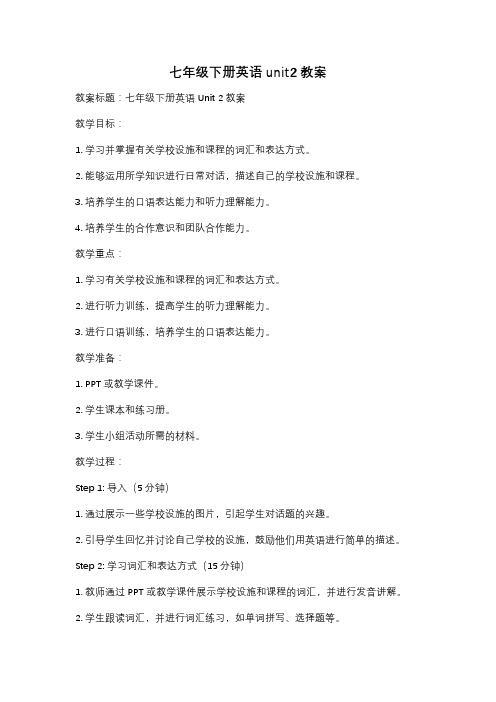
七年级下册英语unit2教案教案标题:七年级下册英语Unit 2教案教学目标:1. 学习并掌握有关学校设施和课程的词汇和表达方式。
2. 能够运用所学知识进行日常对话,描述自己的学校设施和课程。
3. 培养学生的口语表达能力和听力理解能力。
4. 培养学生的合作意识和团队合作能力。
教学重点:1. 学习有关学校设施和课程的词汇和表达方式。
2. 进行听力训练,提高学生的听力理解能力。
3. 进行口语训练,培养学生的口语表达能力。
教学准备:1. PPT或教学课件。
2. 学生课本和练习册。
3. 学生小组活动所需的材料。
教学过程:Step 1: 导入(5分钟)1. 通过展示一些学校设施的图片,引起学生对话题的兴趣。
2. 引导学生回忆并讨论自己学校的设施,鼓励他们用英语进行简单的描述。
Step 2: 学习词汇和表达方式(15分钟)1. 教师通过PPT或教学课件展示学校设施和课程的词汇,并进行发音讲解。
2. 学生跟读词汇,并进行词汇练习,如单词拼写、选择题等。
3. 学生进行词汇对话练习,操练如"How many classrooms are there in your school?"等句型。
Step 3: 听力训练(15分钟)1. 教师播放录音,学生听录音并回答相关问题。
2. 学生进行听力练习,如填空、选择题等。
Step 4: 口语训练(20分钟)1. 学生分组进行小组活动,讨论并描述自己学校的设施和课程。
2. 学生展示他们的讨论成果,分享自己的观点和意见。
3. 教师进行点评和指导,帮助学生改进口语表达。
Step 5: 练习册活动(10分钟)1. 学生完成练习册上与本单元内容相关的练习题。
2. 教师检查学生的练习册,给予必要的指导和反馈。
Step 6: 总结与拓展(5分钟)1. 教师总结本节课的重点内容,并与学生一起回顾所学知识。
2. 鼓励学生运用所学知识进行更多的口语练习,如与同学交流学校设施和课程的情况。
新人教版七年级英语下册 Unit 2二课时-优质教案.doc
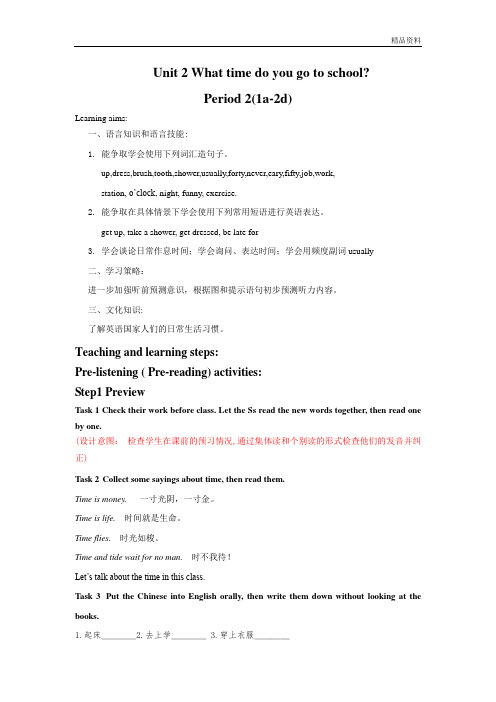
Unit 2 What time do you go to school?Period 2(1a-2d)Learning aims:一、语言知识和语言技能:1. 能争取学会使用下列词汇造句子。
up,dress,brush,tooth,shower,usually,forty,never,eary,fifty,job,work,station, o’clock, night, funny, exercise.2. 能争取在具体情景下学会使用下列常用短语进行英语表达。
get up, take a shower, get dressed, be late for3.学会谈论日常作息时间;学会询问、表达时间;学会用频度副词usually二、学习策略:进一步加强听前预测意识,根据图和提示语句初步预测听力内容。
三、文化知识:了解英语国家人们的日常生活习惯。
Teaching and learning steps:Pre-listening ( Pre-reading) activities:Step1 PreviewTask 1 Check their work before class. Let the Ss read the new words together, then read one by one.(设计意图:检查学生在课前的预习情况,通过集体读和个别读的形式检查他们的发音并纠正)Task 2Collect some sayings about time, then read them.Time is money. 一寸光阴,一寸金。
Time is life. 时间就是生命。
Time flies. 时光如梭。
Time and tide wait for no man. 时不我待!Let’s talk about the time in this class.Task 3Put the Chinese into English orally, then write them down without looking at the books.1.起床____2.去上学____3.穿上衣服____4. 刷牙___5. 洗澡____6.吃早饭____7.你通常什么时间洗澡?___________________________________________________8.我通常在六点四十洗澡。
人教版 新目标七年级英语下unit2六课时(获奖教案)
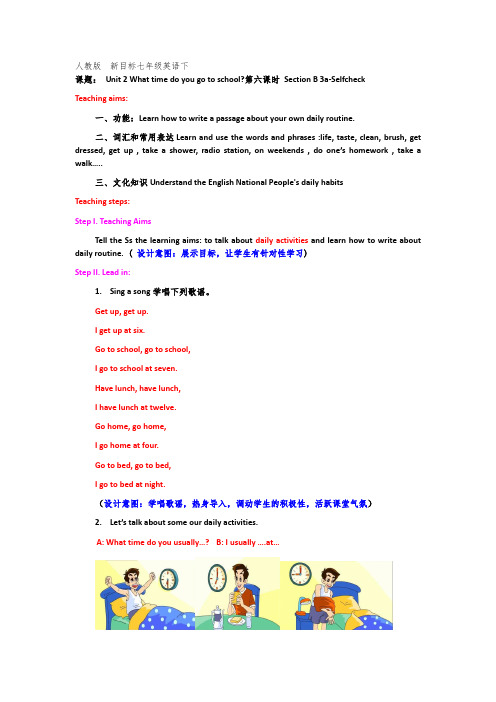
人教版 新目标七年级英语下课题: Unit 2 What time do you go to school?第六课时 Section B 3a-Selfcheck Teaching aims:一、功能:Learn how to write a passage about your own daily routine.二、词汇和常用表达Learn and use the words and phrases :life, taste, clean, brush, get dressed, get up , take a shower, radio station, on weekends , do one ’s homework , take a walk …..三、文化知识Understand the English National People's daily habits Teaching steps: Step I. Teaching AimsTell the Ss the learning aims: to talk about daily activities and learn how to write about daily routine. ( 设计意图:展示目标,让学生有针对性学习)Step II. Lead in:1. Sing a song 学唱下列歌谣。
Get up, get up. I get up at six.Go to school, go to school, I go to school at seven. Have lunch, have lunch, I have lunch at twelve. Go home, go home, I go home at four. Go to bed, go to bed, I go to bed at night.(设计意图:学唱歌谣,热身导入,调动学生的积极性,活跃课堂气氛) 2. Let’s talk about some our daily activities. A: What time do you usually…?B: I usually ….at…get up 起床have/eat breakfast吃早餐get dressed 穿衣服brush teeth 刷牙take/have a shower 淋浴have dinner吃晚饭have lunch 吃午饭go home 回家go to school去上学go to bed 去睡觉do homework 做作业(设计意图:看图说话,对本单元的话题进行复习)Step III.Presentation3a Number these sentences in order to make a story about a daily routine.___ I usually exercise from six to seven.___ I always get up at six.___ After that, I always brush my teeth and go to school at eight.___ Then I quickly have a shower and eat breakfast.___ I have lunch at a quarter to twelve.___ I get home from school at half past four and do my homework.___ I have a very healthy life.___ I have dinner at seven thirty.___ I go to bed at ten.(Answer:3,2,5,4,6,7,1,8,9)Task1 Talk about your daily routine.I usually get up at seven o’clock.I exercise…(设计意图:以展示图片的形式来进一步讨论学生的日常作息习惯,为下一环节写作做好铺垫。
人教版七年级下册英语Unit2优秀教学案例

4.反思与评价:在课堂的各个环节,我引导学生进行自我反思和评价,让他们认识到自己的优点和不足,明确自己的学习目标。同时,我也对学生的语言运用能力和团队合作精神进行了观察和评价,及时给予他们反馈和建议,帮助他们不断进步。
2.引导学生谈论视频中的场景和运动项目,让学生自由发表自己对体育运动的看法和喜好。
3.自然引入本节课的主题"Let's play sports",并提出问题"Do you like sports? What sports do you often play?"激发学生的思考和讨论。
(二)讲授新知
1.通过展示体育器材的图片,如篮球、足球、乒乓球等,引导学生猜测这些器材的英文名称,并让学生用一般现在时进行描述。
2.教师对学生的语言运用能力和团队合作精神进行观察和评价,及时给予学生反馈和建议,帮助学生不断进步。
3.鼓励学生相互评价、相互学习,形成良好的学习氛围,提高学生的自我评价能力和批判性思维能力。
四、教学内容与过程
(一)导入新课
1.课堂开始,我通过播放一段奥运会开幕式的视频,让学生感受体育运动的氛围和激情,激发他们对体育活动的兴趣。
2.设计各种真实而有意义的情境,如模拟体育课、运动会等,让学生在真实的环境中进行语言交流,提高学生的语言运用能力。
(二)问题导向
1.教师提出引导性问题,如"Do you like sports?", "What sports do you often play?"等,激发学生的思考和讨论。
(七年级英语教案)英语七年级下人教新课标Unit2教案
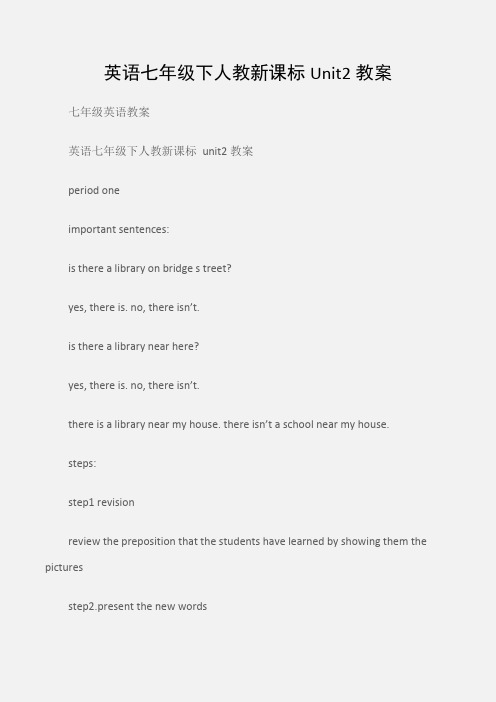
英语七年级下人教新课标Unit2教案七年级英语教案英语七年级下人教新课标unit2教案period oneimportant sentences:is there a library on bridge s treet?yes, there is. no, there isn’t.is there a library near here?yes, there is. no, there isn’t.there is a library near my house. there isn’t a school near my house.steps:step1 revisionreview the preposition that the students have learned by showing them the picturesstep2.present the new wordsshow a map with many buildings in it.t: look at this picture. this is a map of lily’s town. these buildings are near lily’s house. what place is it?s: it is a bank.t: spell it, please.ss: b-a-n-k.repeat with other new wordspost office, park, bank, supermarket, pay phone, street, airportstep3 present the prepositionst: look at the blackboard. what can you see in the picture?s: we can see a supermarket, a bank, a hotel, a park, a postoffice, a pay phone, a restaurant, and a libr ary. so the post office is on bridge street and near here.” is there a post office near here?s: yes, there is. it’s on bridg e street.t: is there a school near here?s: no, there isn’t.t: is there a library on bridge street?s: no, there isn’t. it’s on fifth avenue.show the map and let them practice in pairsis there ……..yes, there is. it’s on center street. / no, there is not.(then do 1a)step4 1 a.this activity introduces the key vocabulary.focus attention on th e picture. ask students to name as many of the places they see in the picture as they can. then name all the places and ask students to repeat.point out the numbered list of words. say each one and ask students to repeat.then ask students to match each word or phrase on the list with one of the pictures.say, write the letter of each place in the picture next to the correct word orwords on the list. point out the sample answer f.check the answers.answers. 1.f 2.a 3.e 4.i 5.c 6.b 7.h 8.g 9.dstep5 1b.this activity gives students practice listening to and understanding the target language.point ou t the buildings and other locations in the picture.say the name of each one to the class.say, now i will play recordings of three conversations. listen carefully and circle thepictures of each place you h ear on the tape.play the recording the first time. students only listen.play the recording a second time. this time ask students to listen and circle the itemsthey hear on the picture.correct the answersanswrers:these items should be circled: video arcade, post office, supermarketstep6 1c七年级英语教案point to the different locations shown in the picture.ask different students to name each one. if necessary, say the name and ask the student to repeat.point to the question and answer in the example conversation and ask a pair of students to read the conversation to the class. ask other pairs of students to repeat the activity if you wish.ask students to work in pairs. say, first one person asks a question and then the other person takes a turn,demon strate the activity. point to the picture and ask. is there a post office near here? then choo se a student to answer. guide the student to say, yes, theres a post office on bridge street.as students work, move around the room and check progress . help students understand how to locate things on the map, if necessary.ask several students to say some of their questions and answers for the class.step7 2a.this activity introduces the terms across from, next to, between, and on.focus attention on the pictures.ask students to talk about the pictures, naming as many places as they can.then name all the places in the pictures and ask students to repeat.point out the four sentences.say each one and ask students to repeat.then ask students to match each sentence with one of the pictures.say, each sentence talks about one of the pictures. wr ite the number of the sentence in the box on the picture that it is talking about. point out the sample answer 1.check the answers.answers: picture1. 4 picture 2. 2 picture 3. 3 picture. 1step8 2b.this activity gives students practice listening and understanding the target language.point out the buildings and street names in la.say each one and ask students to repeat.call attention to the four sentences in 2b.。
人教版七年级英语下册unit2教案

人教版七年级英语下册unit2教案人教版七年级英语下册unit 2教案(一)Unit 2 Section B (1a-2c)一、教学目标:1. 语言知识目标:1) 能掌握以下单词:half, past, quarter, homework, run, walk, clean, quickly, either, either…or…2) 能掌握以下句型:① —When does T om usually get up?—He usually gets up at half past five.② I either watch TV or play computer games.③ It tastes good.2. 情感态度价值观目标:本部分的学习内容仍是对―日常作息时间‖人教版七年级英语下册unit 2教案(二)教学重难点1. 教学重点:1) 让学生们掌握另外两种表达时间的方式。
2) 3)2. 教学难点1) 能听懂学习到的日常活动的时间按排。
2)人教版七年级英语下册unit 2教案(三)教学过程Ⅰ. Warming- up and revision1. Greet the Ss as usual.2. Check the homework.Ⅱ. PresentationWhat timeis it?”。
…和to来回答时间:(1) ―时‖,再说―分‖。
如:six thirty 六点半;seven fifteen七点十九点五十五分。
(2) 先说―分‖,再说―时‖,中间加介词past(半点或半点以内,表示―超过‖)、to(半点以上,表示―差‖)。
如:五点十分;。
quarter past seven 七点一刻;half past nine 九点半;a quarter to twelve十二点差一刻,即十一点四十五分。
Ⅲ. Matching1. Work on 1a: 引导学生将用英语表达的时间与钟表上用数字表达的时间一一配对。
七年级英语下unit2全英文教案五篇

七年级英语下unit2全英文教案五篇第一篇:七年级英语下unit2全英文教案七下第二单元教案第一课时(Section A 1a-2c)(Listening & speaking)Language functions: Is there a bank near here? Yes, there is.It’s on Center Street.Where is the supermarket? It’s next to the library.It’s between the restaurant and the supermarket.Vocabulary: post office, park, bank, supermarket, pay phone, street , across from , in front of ,behind, there, avenue, bridge, Across, across from, next , next to ,between, front, in front to, behindImportant point: Is there a supermarket ? Yes, there is./No, there is not where is ……? It is in front of ……Difficult point: Is there a supermarket ? Yes, there is./No, there is not where is ……? It is in front of ……Learn to ask for and give directions in conversations.Ability target:Train students’ listening and speaking skills.Train students’ communicative competence.Emotion target:All the buildings make our city beautiful.Thank the designers and the workers.Thanks for their hard work.Teaching steps: Step1 Warming-up and revision 1.Enjoy the chant of Grade 6’s Unit 2(以小学熟悉的chant能快速地引起学生的兴趣,让他们迅速地投入上课状态,同时此chant为后面做好铺垫)Where is the post office ? Next to the hospital.Where is the hospital? Next to the cinema.Where is the cinema ? Next to the bookstore.Where is the bookstore ? Go straight ahead.2.Greeting &revise Unit 1 Where are you from? What language can you speak?Where do you live?I live in China/Zhejiang/Pingyang/---Then ask ―What’s this ?‖---It’s a map.---Yes.It’s a map of China.Is this a map?(Show the map of 1a)Step2 word-teaching 1.Direct Ss’attention to the picture on the screen and ask Ss ―What’s this?‖,present the names of the places on the board.(用ppt引出地点,学生可以更直观地感知并掌握单词)2.Give plenty of opportunity for both choral and individual repetition of the new words.(中学生爱表现自己,这步设计可以更好地让学生学习英语的乐趣)Step 3.Match ,listen and pratice1.Finish 1a then check.2.Do 1b listen and check.(提高学生听的能力)3.Work in pairs,then ask two pair to act(让学生在使用中学习英语,以增强信心)Step 4.Teach the prepositions 1.Revise-Where is the soccer ball?(温故而知新)It’s in/on/under the box.2.Teach It’s near/next to /behind/in front of /across from/between –and--(让学生更好地理解这些介词的意义)3.Put the prepositions on the board, have Ss repeated.4.Finish 2a then check 4-6-2-3-5-15.Show the picture one by one by asking and answering--Where is the pay phone?--It’s on/-the Green Street(及时复习巩固)Step 5.Listening 1.Reading the words &sentences before listening(培养学生的听力技巧)2.Play the tape ,listen & check (及时反馈,即使评价,提高学习效率)Step 6.Consolidation and pairwork 1.Fill the blank ,then check(提高上课学习效率,巩固新知识)2.Pairwork : Where is the---? It’s across from/ next to/ between… and …/ on/in front of/behind---(提高学生听说与交际能力)Step 7.Homework 1.Pair works,two students draw the map, one acts as a policeman, the other acts as a a person who is ask the way.2.Draw a sketch map of your home to school or the way to your partner.3.Finish homework 2-1,2 Blackboard design-Is there a...? post office-Yes,there is.It’s on...street./ libraryNo,there isn’t.hotelWhere is the----? restaurant-It’s on/in front of / behind/across from/ bank Near/next to /between—and--supermarketparkpay phone第二课时(Section 3a-4)(Reading & speaking)一.Teaching Aims and Demands1.Ability ObjectTrain students’ listening and speaking skills.Train students’ communicative nguage goals:learn to ask for and give directions on the street.Moral objects On weekends or holidays, invite your friends to your house to have a good time.4.Teaching Key points: Review the key words in this unit二、Teaching steps: Step 1.Warming-up and revisionDaily GreetingStep 1.Warming-up and revision(温故而知新)Daily Greeting(融洽师生之间的关系)Is there a post office near your house ?……Where is---?Then ask some questions about the picture of 3aStep 2.Pesentation.(传授新知识)--Is there a supermarket in the picture?---Yes it is.--Where is it?---It’s between the hotel and the post office.---There is a traffic sign.What does it mean?---It means ―Turn left ‖What other traffic signs do you know? What do they mean?,In the same way present turn lright、/take the...turning.go straight Go up/go down/on the left /right /on your left /right step 3.Reading and speaking1.Read the conversation and find Paul and Nancy in the picture.Then show the position(训练学生的听说读的能力)2.T—Paul SS—Nancy Ask and answer Can you draw the line.?Who can ?Show the line.3.Work in pairs step 4.Work on 3b(巩固新知识,加强英语的综合运用能力)1.Work in pairs(T-go around to guide the student)2.Ask some pairs to act Step5.Summary and Consolidation1.Summary(学习方法指导,加强培养学生的自主学习能力)-Excuse me.Is there a/an … near here?-Yes, there is./ No, there isn’t.-Where is the …?-Just go straight and turn left.It’s down Bridge Street on the right.It’s …behind next to between … and …across from in front ofon-Thank you very much.-You’re welco me.2.Pairwork Who is the most warm-hearted policeman?(提高学生的听说与交际能力)--Excuse me.Where is the bank ?--go straight down Center Street, turn left at Xingfu Street There is a bank on the right.It’snext to the bookshop…Step 6.Guessing Game.(游戏是学生喜欢的活动形式,其可以增加学习英语的趣味性)Goal: This activity provides an oral review of where a place is.Procedures: Invite a student to come to the front of the classroom.And then describe a place which thestudent are familiar with.For example, he or she may say, it is on Center Stree t.It’s next to the supermarket.While he or she is describing the rest take turn asking.Is it a school ? Is it a pay phone? Etc.The game goes on until they can guess it.(提高学生综合运用英语的能力)Step 7 Homework(作业是课堂的延续)1.Summary the sentences of asking and directing the direction2.Write down the route from your home to your school..Draw a picture of your ideal neighborhood.Make up a dialog between a police officer and a passer-by.Blackboard Design-Excuse me.Is there...? go straight Where is...? turn leftWhich is the way to...? turn righ tCan you tell me the way to...? take the...turning第三课时(SectionB 1a-4b)(Listening Reading &writing)一、Teaching aims 1.Vocabulary:open, dirty, old, market, quiet ,house,welcome ,garden, enjoy, walk through ,beginning,tour, visit, place,have fun ,if hungry, 2.Ability target: Train students’ listening ,speaking ,reading &writing skills.Train students’ communicative competence.3.Moral Object Everyone in school take the responsibility to keep our environment clean and tidy.二、Key Points Key Vocabulary.Target language三、Teaching difficulties 1..Practice the adjectives using thetarget language, 2.Train students’ listening ,speaking ,reading &writing skills.3.students’ communicative competence.四、Teaching steps: Step 1.Warming-up and revision Enjoy an English song(用歌曲自然地把学生引入课堂,且能激起学生学习英语的兴趣)Greeting.(融洽教师与学生之间的了解,融洽彼此的关系)Draw a stick-figure picture on the screen,have Ss say the routes between places.Point to two supermarkets.one is big,one is small, have Ss tell the difference, elicit the two adjectives big、small fromSs.(自然地导出新课的内容)Step 2.word-teaching.Show three pairs of items,elicit the three pairs of antonyms.clean-dirty new-old queit-busy.Reinforce with examples Ss familiar with,for example our class is clean,but the W.C is dirty,etc.(在使用中学习英语,在学中用,体现了新课程的理念).Refer to 1a,2a, in Section B.Step3.ListeningWork on 2a,2b.(训练学生的听力,以提高他们听的能力)Check the answers in 2b by asking one student to draw the map of Michaels’ neighborhood on the board.Step 4.Reading (加强学生阅读策略的培养,并为下一步的写打下基础)1.Ask Ss ―Do you have a school trip?‖ ―Do you want to havea school trip?‖―Why?‖etc.Elicit the newwords and phrases.2.work on 3a Before-Reading.Tell Ss that it’s importannt for us to get information from a tour guide if we want to have a tour.Ask Ss ―What info rmation can you from a tour guide?‖elicit answers from Ss.(take notes as Ss answering)the place to visit: the way to the place: how to go to the place:how is the place: While-Reading.Have Ss look at the lists of the items on the board and find the information about in 3asection B..Have one student put the answers on the board..Tell Ss to read the passage aloud,go around and monitor them and help with pronunciation.After-Reading.Say―I don’t live in Yuyang , tell me some interesting places in Yuyang ?‖.Elic it information from Ss,Step 5 working on 3b&writing1.working on 3bthen check(提供一些阅读信息,提供写导游指南的素材)2.Tell Ss to chooose one of the places and write down the four items of the place,and try to link theinformation into a tour guidar..Select some tour guides from Ss at random,check them on the screen,have Ss judge the best one.Step 6.Homework(温故而知新)1.Pair works,two students draw the map, one acts as a policeman, the other acts as a a person who isask the way.2.Draw a sketch map of your home to school or the way to your partner.Blackboard Designclean dirty welcome garden district new old take a walk through quiet busy beginning hungry...Period 4(Revise of Unit 2)一.Teaching Aims and Demands1.Knowledge objectsReview all the key words presented in this unit.Read an e-mail and draw a route2.Ability ObjectTrain Ss’ Reading and writing skill.Moral objects On weekends or holidays, invite your friends to your house to have a good time.4.Teaching Key points: Review the key words in this unitTeaching steps:Step 1.Warming-up and revisionEnjoy an English song(提高学生的学习兴趣)Greeting.Step2 work on shelfcheck-3.1 Scan and find the answers to these questions.(培养快速阅读的能力)(1)When is he arriving?(2)Does he know the way?(3)What does Mike do? 2.Read an e-mail and draw a route 3.read aloud then fill the letter of Jenny(训练学生英语写作的能力)Step 3 Summary1.Summary:(培养学生及时总结的能力,并做一定的示范)Asking the Way:Excuse me.Is there a …near here?Where is the nearest …?Can you tell me how I can get to the…? Can you tell me how to get to the …? Could you tell me the way to the …, please?Which is the way to…?Do you know the way to…Showing the Way:Go down this street./ Walk along this road.Take the first turning on the right./Turn left at the first turning.It’s on your right/left./ It’s next to …It’ll only take you about 10 minutes if you walk there.Step 4 Pairwork(灵活运用所学词汇和句型,培养学生的观察力和对信息的整合能力,训练学生的口语表达能力和演讲技巧)---Excuse me ,where is----/Is there a---Work in pairs---actStep 4 Exercise(目的:复习巩固相关词汇与句型;激发同学之间用英语相互交流的欲望,增强学生的学习兴趣,增进同学之间的友谊)1.Fill in the blanks1.There’s a cinema next ____ the shop.2.____ the left side ofthe room, there’s a desk.3.-I’m sorry I can’t help you.-_______________________________.4.Please come to the front and stand ____________ the class.5.A: ________ _______, where is the nearest police station, please?B: I’m _______, I don’t know.Please ________ that man.A: Thank you _______ ________ _______.Excuse me, where is the police station, please?C: _______ over there, next ________ the post office.A: Thank you ________ _______.C: Not ________ _______.6.A: Excuse me.Which is the____ to East Park, please?B: Let me see.Er, walk _______ this road and ____ right.Go ____ until you _____ the end.You’ll___ the park in front of you.7A: Excuse me.Can you tell me ____ to the post office, please?B: Sure.Go ____ this street and ____ right.Then you’ll see a tall building.That’s the _____ ____, and it s between the zoo ____ the fruit shop.You can’t _____ it.A: Is it ____ from here?B: No, it s quite near.It’ll only ____ you about 10 minutes if you walk there.A: Thanks a lot.B: You’re welcome.答案见课件Step 5.Homework()1.Write a letter to your friend who will visit you but he doesn’t know the way.?2.Finish the exercises below : 1.请问,去车站怎么走?Excuse me.Could/ Can you tell me the way to the station?2.请问,去警察局怎么走?Excuse me.Which is the way to the police station? 3.请问,去动物园我该走哪条路? Excuse me.Which way shall I take to the zoo?4.劳驾,最近的邮局在哪儿?Excuse me, where is the nearest post office?5.请问,你能帮我找到那家水果店吗?Excuse me.Could/Can you help me find the fruit shop6.劳驾,往第十四中学怎么走?Excuse me.How can I get to No.14 Middle School?7.劳驾,附近有医院吗?Excuse me.Is there a hospital near here8.劳驾,去书店怎么走第二篇:全英文教案 Unit2Teaching Plan(45mins)Unit2 English around the world Part 1 :Analysis of teaching materialThe theme of this class is “English language and its development, different kinds of English”.Researching the topic of the development of the history of English language, which can make students strengthen the understanding of the English language, especially for the understanding of the trend of English development.After finished this class, the students can comprehend the variety levels and plurality of English language, which can help students develop the consciousness of intercultural.Part 2: Teaching Aims1.Knowledge Objects①Talk about English and its development, different kinds of English.②Talk about the difficulties in language communication.③Learn to make dialogue by using request & command.④Learn to transfer from Direct Speech into Indirect Speech.⑤L earn to organize ideas and give opinions by the way of brainstorming.2.Ability Objects(1)Important word and phrase Subway, elevator, petrol, gas, official, voyage, conquer, native, come up, apartment, actually, base, at present, gradually, vocabulary, make use of, latter, identity, fluently, frequently, usage, command(2)Grammar and sentence①English is a language spoken all around the world.②Thereare more than 42 countries where the majority of the people speak English.③The number of people who learn Engl ish as a foreign language is more than 750 million.④In China students learn English at school as a foreign language, except for those in Hong Kong, where many people speak English as a first or a second language.3.Moral ObjectsLet the students obtain the knowledge about the development of English language by reading, expand international horizons, aggrandize the culture consciousness, arouse their enthusiasm for English learning.Part 3: Teaching Key Points and Teaching Difficulties1.To be able to get the main idea from the text.2.To be able to solve the problem by analyzing.3.To be able to use the different learning strategies for different reading purposes.Part 4: Teaching method1.Scenario communication method2.Task based Language Teaching method3.The heuristic teaching methodCreate the scenarios, lead in the topic, group discussions and exchange, inspire the learning initiative of student with the heuristic teaching method Part 5:Teaching Procedures Step1: Warming upLet the students look at the following picture, then ask them some questions like these: Which words in the picture are British English or American English? Which country do you think has the most English learners? Step2:Lead inI play a short video about people from England making voyages to conquer other parts of the world, then ask the students: Why is English the most widely used in so many countries? Why has English changed over time?Step3:Fast reading1.Let the students read the text as quickly as they can, then decide whether the statements are true or false:(1)There is no difference between American English and British English.(2)Written English is the same in both American English and British English.(3)Sometimes people from the two countries have difficulty in understanding each other.(4)The English language in the world always stay the same as the language used in Britain.2.Show the students some important words and expressions.(1)include包括,包含(2)play an important role / part in 扮演重要角色(3)even if / though 即使,即便(4)a large number of 许多,大量的(5)communicate with 和...交流(6)be based on 建立在......的基础上(7)make use of 利用,使用 Step 4: Careful reading 1.Let the students read the passage carefully and then make a time line of the development of English.2.Let the students read the passage again and fill in the blanks with the words from the text.It is not easy for a Chinese person to speak English as ___ as a ___ English speaker.One reason is that English has a large ___.It also has different usage in different English speaking countries.If you use “flat”instead of “___”, people in America will know you have learned British English.If you use the word “___”instead of “lift”in Britain, people will know you have studied American English.3.Let the students listen to the text carefully and repeat the sentences.Step 5 :Group workAsk and answer the questions like these: When did five to seven million people speak English? Why did English begin to be spoken in many other countries? Which country may have the largest number of English learners? Step 6 :Practice Retell the history of English and tell the differences of ancient English and modern English, British English and AmericanEnglish.Step 7:SummaryAnswer questions: Tell us what did you learn from this lesson? Why do you think people all over the world want to learn English?Then give “The road to modern English”.Step 8:Homework1.Go over the text and try to learn all the useful words and expressions in this part by heart.2.Write a passage about your English learning.Part 6: After-class reflectionThe essential aim of English teaching is to promote the skills of listening, speaking, reading, writing, and the ability of comprehension, and to strengthen their consciousness of cross cultural communication.The four skills link closely, and they do not exist in isolation, this lesson will integrate these four links to the whole teaching process, which make students basically achieved the knowledge of this lesson and enable students to systematically understand the knowledge they have learned.At the same time, we can achieve the teaching aim of this class.第三篇:七年级英语下unit2课件七年级英语下unit2课件Can you play the guitar?一.Knowledge and abilities goals:1.vocabulary:dance,swim,sing,play chess , paint ,speak English, play the guitar2.How to use Model verb” can”.3.Listen ing and speaking skills and communicative competence.二.Teaching method: Listening and speaking methods.Pair works.三.Moral goals: Encourage students to express their abilities.Content of courses: In this period, students will learn some names of clubs ,such as art , music, chess club, swimming club, etc.students will learn the drills :Do you want to join…club ?Can you …?四.Importance and difficulty: canTeaching Aids: A tape recorder.Some pictures.A projector Some sports things, such as volleyball, basketball, etc.Preparation test paper for lessons before class.五.Teaching Time: 4 periods Period 1(Section A: 1a-2d)授课人:______ 授课班级: _____ 授课时间:2016年___月___日____午第____节1.Knowledge Objects: Learn to talk about abilities.Know something about the culture of clubs.Can you/he..?What can you do? What club do you want to join?can, can’t, draw, dance, swim, speak, walk.2.Teaching key point: can3.Teaching Difficult point: can4.Teaching Procedures:Step 1.Lead-inEnjoy a song I’m a musicianT: Do you want to be a musician? S:T: Can you play the piano? S…T: What can you do? S: I can…T: What about you? S:T: OK, now please show your talent and tell us what you can do.Ask one of the students come to the front and do the action.Ask other students to guess what he or she can do.Step 2.PresentationT: Look at the pictures.What are they doing? S:Step 3 Pair workLook at the pictures.Ask and answer like this:A: Can you play basketball?B: Yes, I can./ No, I can’t.Can you…?Step 4 PresentationShow some pictures of famous stars.Practice the third person “he, she, they”T: Where can you play chess? S:T: Yes, in a chess club.This term, we have a lot of clubs.What club do you want to join? S…T: Sounds great.Can you…?S: Yes, I can/ No, I can’tIf the answer is negative, guide students to say:S: No, I can’t.But I can learn it from others.Step5 Pair work A: What club do you want to join?B: I want to join the…A: Can you …?B: Yes, I can.No, I can’t.But I can learn it from others.Step 6 ListeningListen to 1bListen to 2a and 2b.Tell them to give special attention to listening activity(names of the clubs).Finish the tasks.Step 7 Pair workLook at 2b and talk about what the people can do the clubs they want to join.Step 7 Role-play the conversation 2d T: If you like telling stories.What club can you join?S: Story telling club.T: Right.Please read the conversation following the recording.Who wants to join the story telling club? Then role-play the conversation.Step 8 Explain some language points.Step 9 Homework第四篇:七年级上册英语unit2教案Period 1 Section A 1a1c Ⅰ.教学准备1.教师:录音机和录音磁带,多媒体课件、麦克风、自己的家庭照片。
(完整版)新版-人教版七年级英语下册第二单元教案

Unit 2 What time do you go to school ?一.考点,热点回顾【重点单词】time get shower usually o'clock work hour brush teeth after hotel all night love listen home job am homework letter around start write tell soon best wish survey awake【重点短语】what time go to school get up take a shower go to workdo homework go home【重点句子】1.What time do you usually get up ? I usually get up at five o'clock.2.What time does Alice take a shower ? She usually takes a shower at 9:003.What a funny time to eat breakfast.4.To get to work, he takes the number 17 bus to t hotel.5.Can you think what his job is ?6.What time is it ? I t's eight thirty.【重点语法】----询问“时间”的特殊疑问句What time 用来提问“几点几分”,有时候可以用when代替构成如下:1.询问时间--what time is it now ?---It's five o'clock.2.询问某人在几点做某事What time do / does + 主语+ 实义动词原形+ 其他---What time do they go to school ?---They go to school at 7 o'clock.如何写有关谈论日常休息的话题常用句型:1.I usually get up...2.Sometimes I ...3.Then I ...4.At 8:00 I...【课文重难点】ually 通常频度副词,意为“通常”。
人教版七年级英语下册Unit2教学设计
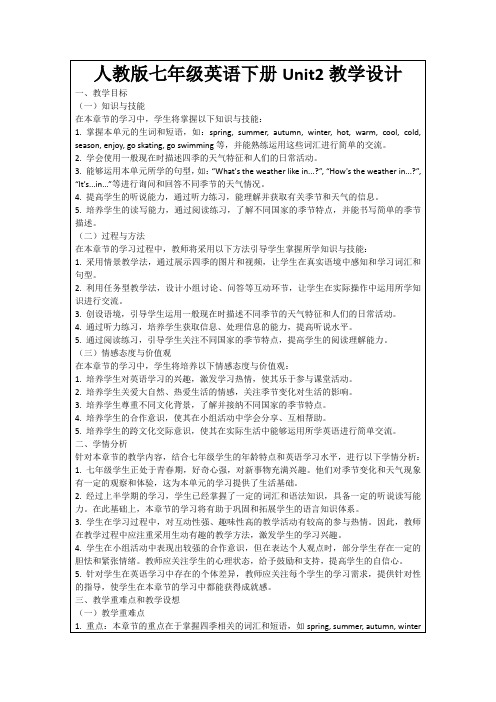
一、教学目标
(一)知识与技能
在本章节的学习中,学生将掌握以下知识与技能:
1.掌握本单元的生词和短语,如:spring, summer, autumn, winter, hot, warm, cool, cold, season, enjoy, go skating, go swimming等,并能熟练运用这些词汇进行简单的交流。
(4)每组选派代表进行汇报,教师对各组的表现进行评价和总结。
(四)课堂练习
1.教学活动设计:
(1)设计听力练习,让学生听取关于季节和天气的对话,完成相关任务。
(2)设计口语练习,让学生两人一组,运用所学句型进行对话练习。
(3)设计书面练习,让学生完成与本单元话题相关的写作任务。
2.教学过程:
(1)教师播放听力练习,学生听取对话并完成相关任务。
3.创设语境,引导学生运用一般现在时描述不同季节的天气特征和人们的日常活动。
4.通过听力练习,培养学生获取信息、处理信息的能力,提高听说水平。
5.通过阅读练习,引导学生关注不同国家的季节特点,提高学生的阅读理解能力。
(三)情感态度与价值观
在本章节的学习中,学生将培养以下情感态度与价值观:
1.培养学生对英语学习的兴趣,激发学习热情,使其乐于参与课堂活动。
1.针对教学重点和难点,采用以下教学策略:
(1)利用多媒体教学手段,如图片、视频、歌曲等,为学生提供丰富的视觉和听觉刺激,帮助其形象记忆四季词汇和句型。
(2)设计多样化的课堂活动,如小组讨论、角色扮演、问答等,让学生在实际语境中练习和运用所学知识。
(3)注重分层教学,针对不同学生的学习需求,提供个性化的指导,提高教学效果。
人教版七年级英语下册第二单元教案(整单元教案)

人教版七年级英语下册第二单元教案Unit 2What time do you go to school?一,指导思想:1,坚持以学生为中心,以任务为主的教学原则;2,给学生创造说英语的机会,贯彻英语学习的交际性原则;二,教材分析:本单元是教材的十一单元,它以学生最为熟悉的日常作息习惯为谈论话题,通过对句型:--What time is it?--It is six.--What time do you usually getup?--I usually get up at six a.m.练习时间的表达和询问方式,同时逐步的培养学生合理安排时间的能力。
整个单元以谈论日常作息时间安排为主线,将日常生活中所涉及到的语言、词汇和时间的表达法融入一系列的小任务中,初一的学生通过完成一个个的任务达到交际的目的,从而能够合理的安排自己的作息时间;且初步了解时差。
三:学生情况分析:我所教的是两个层次不同,基础不同的班级。
学生英语基础参差不齐,对英语的态度也各不相同。
宏志班的学生基础较好,上课积极性较高,各项活动都能顺利开展。
而另一个实验班的学生英语基础不太好,很多学生存在偏科现象,教学时需要照顾到不同层次的学生,因此给平时的教学添了不少难度。
由于面向的学生不同,所以在教学方法及教学任务等方面,两个班级要采取不同的策略。
四:课时划分:本单元共分为四课时:第一课时:Section A(1a-1c)第二课时:Section A(2a-2d)第三课时:Section B(1a-1e)第四课时:Section B(2a-Self-Check)五:教学内容:第一课时交际教学法兴趣教学策略合作学习Step 3, Learning them , ask some students toact these actions out ,theother students guess whatthey are doing .get upbrush teethgo to schoolget dressedperform them .他学生用英语说出这些短语,既达到了巩固新知识的目的,又调动了学生的学习积极性。
- 1、下载文档前请自行甄别文档内容的完整性,平台不提供额外的编辑、内容补充、找答案等附加服务。
- 2、"仅部分预览"的文档,不可在线预览部分如存在完整性等问题,可反馈申请退款(可完整预览的文档不适用该条件!)。
- 3、如文档侵犯您的权益,请联系客服反馈,我们会尽快为您处理(人工客服工作时间:9:00-18:30)。
课题:Unit 2 What time do you go to school?第六课时Section B 3a-SelfcheckTeaching aims:一、功能:Learn how to write a passage about your own daily routine.二、词汇和常用表达Learn and use the words and phrases :life, taste, clean, brush, getdressed, get up , take a shower, radio station, on weekends , do one’s homework , take a walk…..三、文化知识Understand the English National People's daily habitsTeaching steps:Step I. Teaching AimsTell the Ss the learning aims: to talk about daily activities and learn how to write about daily routine. ( 设计意图:展示目标,让学生有针对性学习)Step II. Lead in:1.Sing a song学唱下列歌谣。
Get up, get up.I get up at six.Go to school, go to school,I go to school at seven.Have lunch, have lunch,I have lunch at twelve.Go home, go home,I go home at four.Go to bed, go to bed,I go to bed at night.(设计意图:学唱歌谣,热身导入,调动学生的积极性,活跃课堂气氛)2.Let’s talk about some our daily activities.A: What time do you usually…?B: I usually ….at…get up 起床have/eat breakfast吃早餐get dressed 穿衣服brush teeth 刷牙take/have a shower 淋浴have dinner吃晚饭have lunch 吃午饭go home 回家go to school去上学go to bed 去睡觉do homework 做作业(设计意图:看图说话,对本单元的话题进行复习)Step III.Presentation3a Number these sentences in order to make a story about a daily routine.___ I usually exercise from six to seven.___ I always get up at six.___ After that, I always brush my teeth and go to school at eight.___ Then I quickly have a shower and eat breakfast.___ I have lunch at a quarter to twelve.___ I get home from school at half past four and do my homework.___ I have a very healthy life.___ I have dinner at seven thirty.___ I go to bed at ten.(Answer:3,2,5,4,6,7,1,8,9)Task1 Talk about your daily routine.I usually get up at seven o’cl ock.I exercise…(设计意图:以展示图片的形式来进一步讨论学生的日常作息习惯,为下一环节写作做好铺垫。
)Task2 3b Write about your own daily routine.★写作指导:◆回想一下上个环节中自己一天的作息。
◆按时间的先后,逐条叙述。
◆注意运用正确的英语表达方式:I+ usually/often+动词短语+at+时间。
1. Give the Ss several minutes to write their composition. Choose one student to write his/her own daily routine.on the Bb.2. After all the Ss finish writing, first check the composition on the Bb together with all the Ss according to the following evaluation scale.Choose several Ss to evaluate the composition item by item in the evaluation scale.3. Then, ask the Ss to check their partner’s composition according to the above evaluation scale.4. Choose several Ss to read their composition. The other Ss listen carefully and prepare for answering the teacher’s questions later on.(设计意图: 典型展示→师生评价→生生互评)5. Check the answers. Then ask the Ss to read the whole passage for consolidation.One possible version:I have a healthy life. I usually get up at seven. I exercise from a quarter past seven to half past seven. Then I have breakfast and brush my teeth. I go to school at eight o’clock. I have lunch at twelve o’clock. I get home from school at half past four and do my homework.I have dinne r at six then I watch TV. I go to bed at nine thirty.(设计意图:让学生总结写作要点,文体结构分析,)Task3 Think about your weekends’ activities then fill in the blanks.Activities Timemorning get upexerciseeat breakfastnoon have lunchafternoon play sportsmeet friendsevening eat dinnerwatch TVgo to bedI have a relaxing weekend. I usually get up at eight. Then I exercise for half an hour. I eat breakfast at nine. I brush my teeth at nine past twenty. I …周末人们的作息按排常与工作日不相同,请你写一篇小短文来介绍一下你的周末作息按排。
➢起床、早饭、午饭、晚饭及睡觉的时间。
➢学习、娱乐活动。
➢其他常做的运动及日常活动。
(设计意图:口笔头综合运用,进一步巩固写作要点)Step IV Selfcheck★Make phrases with the words in two circles first.(Answer: taste good, clean my room, have a good job, get dressed, brush your teeth, take a walk )2. My grandparents are very healthy. They always ___________ after dinner.3. You need to _______________ after eating to have good teeth.4. He _____________. He works at a radio station.5. Here are your clothes. Go and _______ quickly!6. I don’t have time to ______________ from Monday to Friday. So I clean it on weekends.➢思路指导:➢首先,应通读所有选项,掌握每个词组的意思。
➢然后,认真读每句话的意思,抓住句子中的关键词,确定应用哪个词组。
➢最后,通读各个句子,检测意思是否正确、通顺。
( Answer:1.taste good 2. take a walk 3. brush your teeth 4. has a good job 5. get dressed 6.clean my room)★★Complete the conversations with questions and answers. Use the words in the brackets to help you.1. A: _______? (your mother/usually/get up)B: ____________ (5:45)A: _____________ (why/get up/so early)B: ___________ (always/ make breakfast for me)2. A: ___________? (you/usually/get to schoolB: ____________ (7:30)A: _________ (your class teacher / usually / get to school)B: I don’t know. But he/she is never late for the first clas s in the morning.➢思路指导:➢本题要求根据提示词补全对话。
